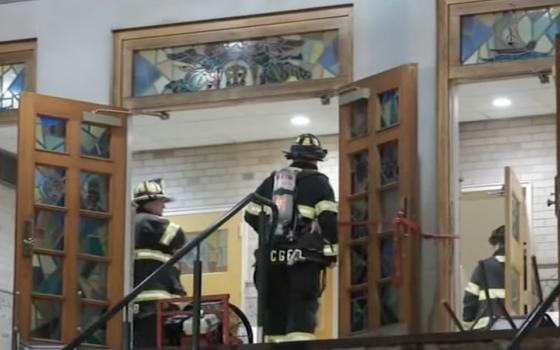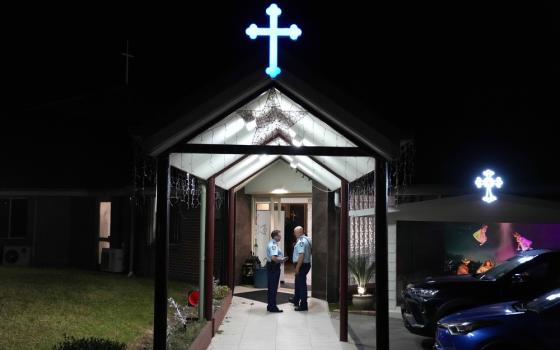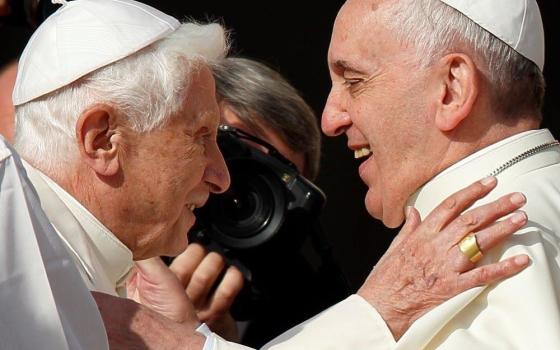
Part of the "In Search of the Emerging Church" series
She is listed on one Web site as belonging to a "set of people" who "are unfortunately acting like JUDAS -- Just Undermine Doctrine And Spirituality," the designation complete with garish red upper case letters.
OK, so it's not difficult to find off-the-wall extremes in the Catholic ether, and Sr. Christine Schenk, executive director of FutureChurch, is somewhat accustomed to being depicted, in her words, as heir to "the bad girl of the Bible."
All of that, however, may say more about how deeply invested we are these days in caricature rather than truth about such matters. In most cases the reality -- conservative to liberal -- is usually less jagged around the edges and more complex than the opposing side would like to think.
In the case of Schenk, the sound bite composite of what she's about -- ordain married men, ordain women, solve the priest shortage -- is as unfair as it is easy to construct.
The reality is that FutureChurch, an organization based in the Cleveland diocese, was one of the first, if not the first, Catholic church groups to understand the deep implications of the growing priest shortage and to begin to act on information that was available to many but spoken about by almost no one. There is, at this point in history, a certain poetic balance to FutureChurch's existence in the diocese, which is going through the throes of a realignment caused largely by the priest shortage.
FutureChurch was organized here in 1990 when the parish council of the Church of the Resurrection, following an eight-month study, passed a resolution in response to a decision by the U.S. bishops to initiate the ritual permitting Sunday worship in the absence of a priest for parishes that didn't have access to Mass on Sunday.
That was a time when parishes in some dioceses could still imagine doing such a thing and when organizers like Schenk could go to the local bishop (it was Anthony Pilla at the time) "to be clear that we respected church leadership and that we respected his leadership. We knew that the decision-making for these issues rested not with him but in Rome," Schenk said in an extended interview in Cleveland in April. The group told Pilla that "we would always do everything we could to be respectful of his leadership, but that we would be public about our concerns." In return they asked that he "avoid undercutting the legitimate theological presuppositions about married priests, and certainly in 1990, the whole discussion of women's ordination, which had not been opposed yet by Rome."
The group was ahead of its time in understanding the problem and took advantage of the leading edge of research that eventually would define one of the fundamental realities that now shapes any conversation about where the church is headed -- there just aren't and won't be enough priests to continue to organize the Catholic community as it has been.
Anyone searching for what might be emerging in the church of the future would do well to pay a visit to Schenk.
That is not to suggest that Schenk and her organization -- which has grown from 36 people representing 16 faith communities in the Cleveland area to 5,000 members from across the country and internationally -- have an inside track at the Vatican or influence with U.S. bishops. Quite the contrary. As one writer once put it, she is among those Catholic idealists who advocate for change but are under no illusions about what they might change. Groups like FutureChurch are at a point in history where they keep assembling the information, educating and wondering what will come of it all.
Let's organize
What about doing nothing and waiting to see what happens? One gets the sense that Schenk is genetically incapable of such passivity. There's a community organizer in her background, and an activist in the Civil Rights era. "It's not good to sit on your anger," she said at one point in the conversation, "You've got to organize."
And so she has.
One of the first things that FutureChurch did was exploit the data that had been generated by sociologists Richard Schoenherr and Lawrence A. Young for their groundbreaking 1993 book, Full Pews and Empty Altars: Demographics of the Priest Shortage in the United States. Schoenherr had been working on the issue for years and the project that resulted in the book was originally sponsored by the then United States Catholic Conference (now the United States Conference of Catholic Bishops) with a grant from the Lilly Endowment. However, as the picture emerged of a church that would increasingly suffer a shortage of priests, some high profile bishops began to disparage the work and ultimately the conference pulled its support.
The work continued under different auspices. Schoenherr's and Young's gloomy predictions may have proven an inconvenient truth for the hierarchy, but it was solid social science that has held up in the years since as the numbers of ordained clergy continued to fall off.
If the bishops didn't like the data, they couldn't refute it. "We were able to use that data diocese by diocese when we went out with our work to let Catholic people know what was going to happen. Over about three years, I probable spoke at about 60 or 70 dioceses," said Schenk. "I lost track after a while."
The organizer had a strategy. She coordinated often with chapters of Call to Action and other local reform groups who would notify the religion writer at the local paper. "We would go in with the statistics from Schoenherr-Young. The news media would go to the diocese and say, 'Is this true?' The diocese would say, 'Yes, it's true,' and then the whole story would come out. Very often it was the first public acknowledgment that the diocese made that yes, the priest shortage was real and it was happening."
All of that occurred between 1995 and 2000.
The group had also developed a program called The Future Priestly Ministry that "laid out all the other ways of meeting the sacramental needs of Catholics besides a male, celibate priesthood," Schenk said. "It had information about a married priesthood and the history of celibacy. It also had materials about women's roles in the church, going back to Jesus and the women [of the New Testament] and the whole history of the suppression of women's leadership in the church."
But then came Pope John Paul II's 1994 apostolic letter Ordinatio Sacerdotalis that declared ordination is reserved to men and slammed the door on any discussion of alternatives to an all male celibate clergy. By extension, most parishes slammed the door on the discussion, so FutureChurch had to adjust. The group developed a second project inspired by a study done by the Leadership Conference of Women Religious that named 15 things that could be done now to advance women's roles in the church.
Rehabilitating Magdala
The new program meant "putting the whole issue of ordination on the side because women's roles in ministry in the church is a much more convoluted effort politically than the issue of a married priesthood. There was a lot of work that needed to be done on that, so that led us into the whole issue of our Mary of Madgala celebrations."
Schenk and FutureChurch probably had the greatest effect of any single group in rehabilitating, at least for a U.S. audience, the woman who had previously been depicted by male preachers as the reformed prostitute of the New Testament. It all went with raising awareness about biblical women. "When we first launched the study in 1997 or 1998, we were actually written up in The Wanderer saying this is terrible and heretical. In fact, when they checked their facts, they found out that in 1969 the Vatican had acknowledged that she wasn't a prostitute."
FutureChurch began with a few Magdala celebrations, 23 to be precise, around 1997, and the following year the number grew to 153, "and ever since then, we've had between 250 and 400 a year."
"What I realized is that this Mary of Magdala, retrieving historical memory, was touching something very deep in the psyche of women because much as we love Jesus and revere our Catholic Christian tradition, most of us never saw ourselves in the Jesus story because it has always been presented to us as Jesus and 12 men," Schenk said.
"Lo and behold, once we get into the biblical scholarship that's not the case at all, because we know the Galilean discipleship had both women and men."
Schenk speaks with certainty of such things now, and she acts with assurance even though Vegas would give slim odds on her accomplishing the kind of radical change she has in mind for the institutional church. It is difficult to imagine a time when she thought of herself as "a little corn-fed hick from Lima, Ohio" convinced that she'd never get the scholarship to Georgetown University that a priest in high school had encouraged her to pursue. But even back then she thought of herself as "high energy and pretty smart." She got the scholarship and eventually the degree. Then a master's in nursing from Boston College. And later, in 1993, a master's in theology.
All of that and experience as a community organizer with the United Farm Workers Union in Philadelphia and a nurse midwife in Cleveland working with low-income pregnant women. She was 25 before she joined a religious order, the Medical Mission Sisters, with whom she stayed for six years. "But I kept getting depressed and I wasn't so sure about the celibacy thing, so I left. About five years later, I found out I was horribly hypothyroid, and that cured the depression once I figured it out."
In the meantime, she had become deeply involved in her parish and fallen in love with a guy, but it didn't work out. She stayed in touch with her Medical Mission friends, and kept dating, but "it seemed like every time I was dating, I was two-timing God. I just couldn't shake it."
She also kept going on retreats and ultimately realized that religious life "was really my life path." So she joined the Sisters of St. Joseph but not before confessing "that my whole life I seem to end up getting into these causes that can be edgy, and if that was a problem, we had better talk about it." Apparently they were then and continue to be just fine with "edgy." "They have been terrific from the beginning," she said.
The order supported her work with FutureChurch for the first three years until it was clear that it "could become a real organization." The order's leadership "really believed in what we were trying to do, and it's because of them and their belief in the mission that we are around."
Pursuing a bigger God
As much as the mission may appear to be advocating for ordination of married men and women, it is just as much aimed at preserving Catholic communities. She knows all about the demographic shifts underway and the effects of the clergy shortage. She doesn't believe all parishes should be saved, but she does believe that instead of simply mandating downsizing to better match the number of parishes with the number of priests, dioceses should look into alternatives -- from greater use of lay parish coordinators to encouraging greater economic sharing among rich and poor parishes. And, somewhere down the road, even ordaining people who now are excluded from that level of leadership.
Her motivation at times is personal. She took her master's degree in theology at St. Mary's Seminary and Graduate School of Theology in Cleveland. Her thoughts initially didn't run to ordination. "I was just so glad to have the opportunity, but when I was finishing and my classmates were being ordained and I wasn't, I got it at a whole other level how wrong this was." Her teachers loved to hear her preach and wished they could hear more of her, but there came a time when the pulpit became off limits to her as her male classmates moved on.
"It was at a much deeper level that I recognized what a violation this was of the call of the Spirit in a person. I went through a pretty big grief time, but I have always been blessed with wonderful spiritual directors and I still am."
Since then, she said, she's "come to the realization that my deepest call is more about reform than ministry. I have to say [being prohibited from ordination] was extraordinarily painful because I loved all the theology. I was growing by leaps and bounds inside, and then to see that that was cut off by something as arbitrary as gender. If anything, that fuels my passion for the work I'm doing now."
Her consolation now is the understanding that "Jesus struggled his whole life with his religious tradition. He was about helping it come to a fuller awareness of the breadth and depth of the love of God and stretching their own boundaries. I feel like I'm following a good path there."
She says she regularly checks her motivation. "I ask myself, 'Where is this coming from? Is this coming because you're mad or because it's a passion about being about that big and wide reign of God like Jesus was?" If it's done out of some sense of political correctness, she said, it won't last. "The other thing is far deeper. I console myself that Jesus was rejected by his own tradition and so was Paul. He was thrown out of all the best synagogues in the Mediterranean world, so when I get upset that one diocese or the other won't let me speak on church property, I just remind myself that it's all part of it. … The end result is going to be so worth it."
What is the end?
"The end result is that we can come to a bigger knowledge of how wide the love of God is."
 ------------------------------------------------------------------------------
------------------------------------------------------------------------------
Tom Roberts, NCR editor at large, is traveling the country reporting on parish life. He is on the first of several trips he plans to take, this time moving through Ohio, eastward into New Jersey and on to the nation’s capital. His e-mail address is troberts@ncronline.org. Read the full series here: In Search of the Emerging Church.
--------------------------------------------------------------------------------
Follow Tom Roberts on his journey "In Search of the Emerging Church." Sign up to receive an e-mail alert when his stories are posted to this series. If you already receive e-mail alerts from NCR, click on the button that says "update my profile."
--------------------------------------------------------------------------------




